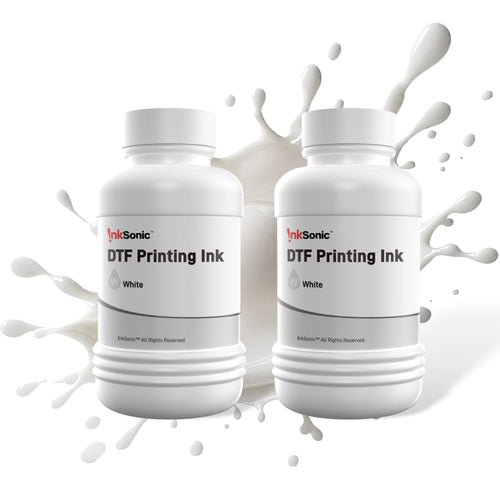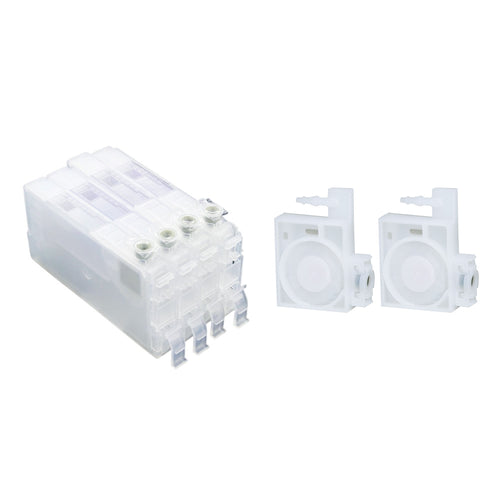For years now, inkjet printers have been a staple in both homes and offices, thanks to their affordability, ease of use, and ability to produce vibrant color prints on demand. But have you ever wondered how an inkjet printer actually works and what it really is?
What is an inkjet printer and how does it work?
Simply put, an inkjet printer is a type of printer that creates images and text by spraying tiny droplets of liquid ink onto paper. Inside the printer, there are special nozzles that carefully place the ink in the right spots to form letters, photos, or graphics. The printer moves the paper underneath the printhead as it sprays, making sure everything lines up perfectly. This process allows inkjet printers to produce colorful, detailed prints that look great, whether you’re printing family photos, school projects, or creative designs.
Inkjet printers are able to spit out anything from plain text to stunning photos by shooting droplets of ink onto paper.

Primary Components and Features of an Inkjet Printer
Inkjet printers rely on several coordinated parts and processes to turn digital designs into crisp prints.
At the core are the ink cartridges , which hold liquid ink in separate compartments for black and colors like cyan, magenta, and yellow.

As a print job is sent off from your device or computer, printing commences as the printer converts digital data into precise instructions. Microscopic printhead nozzles spray very tiny droplets of ink next, tightly controlling their position to form intricate text and images. Paper is moved repeatedly under the printhead by the printer in an effort to obtain the required precision.

Finally, after the droplets hit the paper, they dry quickly, leaving behind clear, vibrant prints that are ready to handle almost immediately.
Features of Inkjet Printer
Now that we’ve covered the how inkjet printers work, it’s time to focus on what makes them unique.
Inkjet printers' greatest advantage is probably the high resolution prints that is so detailed, one can, and it's commonly done so, even see pores and facial imperfections on close range portraits (that's not a rumor, you can actually test it and see for yourself).
They’re also color-centric: you’ll find colors vivid, prints bright and true-to-life, and text sharp and professional.
Beyond paper, inkjet printers are impressively versatile, capable of printing on materials like fabrics, plastics, and specialty media, which makes them useful for crafts and customized products.

Their compact size is another plus, as they fit easily into home offices or small workspaces where room is limited. Finally, inkjet printers are affordable, offering a budget-friendly entry point for personal users and small businesses that need reliable color printing without the high upfront cost of larger commercial machines. This unique blend of quality, flexibility, and cost-effectiveness explains why inkjet printers remain a favorite in both creative and everyday environments.
Applications of Inkjet Printers
Inkjet printers have many uses in different fields. Here are some of the most popular applications:
1. Home and Office Printing
- Documents: An inkjet is mostly used for routine documents, including reports, essays, resumes, and letters. They can also work for home offices and small businesses because they’re cheap and can print in black and in color.
- Photos: This is great for hobbyists or small businesses that have to constantly print pictures.
2. Photography
- The photo-quality capabilities of inkjet printers have made them an increasingly popular favorite among photographers who are looking for vivid, high-resolution prints. Photographers love printing on inkjet printers to create a vivid image on many types of paper such as glossy photo paper and slip-sheets of paper used for home printing invitations and such.
3. Graphic Design and Art
- Illustrators and designers worked with inkjet printers as a replacement for pen plots to reproduce their artwork, illustrative and graphic design work. They have very fine surface detail and are ideal for applications requiring fine runs and deep colour rendering.
4. Textile Printing


Inkjet technology has developed so much that it is applied in textile printing today. Printers can currently spray textiles inks on fabric in order to create customized designs for apparel, home textiles, and upholstery.
5. Labeling and Packaging
- Inkjet printing is frequently used to print labels, barcodes, and packaging designs. They are used in businesses to print unique labels for products or packages and stamp serial numbers, expiration dates, and so on on packages.
6. Commercial and Industrial Use
- In commercial spaces, inkjet printers play a crucial role in producing large-format materials like posters, banners, and signs. These wide-format inkjet printers are specifically built to manage those bigger prints while delivering top-notch quality.
- On the other hand, industrial inkjet printers are utilized for high-speed printing in manufacturing settings, capable of printing on various surfaces like plastic, glass, or metal. They're often employed for product coding and marking, making them essential in many production processes.
7. Medical and Scientific Applications
- In the medical field, inkjet printers are used to print on specialized labels for medication, specimen containers, and diagnostic equipment.
- In research and development , scientists use inkjet printers for creating microarrays (used in genetic research) and printing on specialized materials for experiments.
8. DIY and Crafting

- If you're into DIY projects and crafts, inkjet printers can be a fantastic addition to your toolkit. They allow you to print custom designs on all sorts of materials, from paper and cardstock to fabric and even wood. It's no wonder they're a hit with hobbyists who love creating greeting cards, scrapbooks, and other personalized items!
Inkjet vs Laser Printer, What's The Difference?
The main differences between inkjet and laser printers come down to their printing technology and the tasks they handle best. Inkjet printers work by ejecting tiny droplets of liquid ink directly onto paper, which allows them to produce rich, vibrant colors and fine details. This makes them especially popular for printing photos, graphics, and creative projects . In contrast, laser printers use a laser beam to fuse powdered toner onto paper, resulting in sharp, clean text that’s perfect for high-volume document printing.
The main differences between inkjet and laser printers lie in their printing technology and applications:
- Printing Technology: There is a vast difference because inkjet printers eject liquid ink onto paper, whereas laser printers use a laser beam to bond toner onto the paper.
Print Quality: Inkjet printers are awesome with color reproduction. They are ideal for photos and images, but laser printers are faster for bulk document printing.
Print Speed: Laser printers are quicker for large-volume printing, and ideal for efficient document processing, whereas inkjet printers focus more on print quality, typically with slower speeds.
Cost per Page: Laser printers generally have a lower cost per page, but inkjet printers may be more cost effective for smaller print runs, especially for highly customized prints.
Advantages of Inkjet Printing: Who Needs This Technology?
After comparing inkjet printers with laser printers — from print quality and speed to cost considerations — it becomes clearer why each type appeals to different users. But who exactly chooses inkjet printers, and why do they remain so widely used despite the competition? To answer this, let’s look at the typical audience for inkjet printers and explore how their unique strengths make them especially attractive to home users, creative professionals, small business owners, and anyone needing affordable, high-quality color printing.
Small Businesses: Inkjet printers are affordable and support low minimum order quantities, making them great for small businesses or startups needing small-batch custom prints, reducing initial investment costs.

Creative Industries: For designers, photographers, and artists, inkjet printers offer color accuracy and fine detail, ideal for photo-quality prints and art prints.
Clothing and Promotional Markets: On-demand T-shirt, sportswear, hat, etc., custom production is made possible with Inkjet technology. DTF technology provides long-lasting, durable prints on wash-resistant materials.

Common problems and how to resolve them
Though inkjet printing is one of the very most efficient, it comes with some drawbacks. You really can increase the efficiency and quality of your prints by identifying these problems and applying the correct fixes. Here are a few common issues, and how to fix them:
Problem |
Cause |
Solution |
Clogged Nozzles |
Dried ink or prolonged inactivity causes blockage in the nozzles. |
Use the printer’s automatic head cleaning function and clean the printhead regularly. If severe, manually clean with specialized cleaning fluids, but be careful not to damage the head. |
Inconsistent Colors |
Incorrect ICC profiles or misconfigured color management systems cause color discrepancies. |
Make sure your color management system is properly configured and that you're using calibrated ICC profiles to keep your colors consistent. |
Material Limitations |
Standard inks may fade or peel off fabrics or rough surfaces. |
After curing the print using UV DTF technology and adhesive film, transfer to a hard surface ensures the print is long-lasting and durable, overcoming the limitations of traditional inks. |
Slow Print Speed |
High-quality print modes reduce production speed. |
Switch to high-speed printing mode to improve production speed while maintaining the necessary print quality for large batches. |
Printhead Issues |
Over time, printheads accumulate ink residue or dirt, affecting spray precision. |
Regularly maintain the printhead using cleaning programs to keep nozzles clear. If using a CISS system, ensure even ink supply to prevent leaks or blockages. |
CISS Malfunctions |
Incorrect installation or poor maintenance can cause uneven ink supply. |
Regularly check the CISS system for smooth ink flow and clear any blockages in pipes and cartridges to ensure a stable ink supply. |
Waste Ink Disposal |
Waste ink generated during head cleaning may clog disposal tubes over time. |
Use a waste ink container and clean the disposal system regularly to avoid excess ink accumulation, reducing waste and easing system strain. |
Why Are DTF/UV DTF Printers Gaining Popularity?
DTF printers are actually a specialized type of inkjet printer , and they, along with UV DTF printers, have seen remarkable growth in recent years. This is largely thanks to their ability to produce durable, high-quality prints on a wide variety of materials.
This is largely because the films they print on are able to produce durable, high-quality prints on a variety of fabrics. According to a 2024 Grand View Research market report, the global digital textile printing industry — including DTF — was over USD 2.6 billion and is expected to grow at a CAGR of more than 11% between 2025 to 2030. This is driven by small firms, custom t-shirt shops, and gift personalizers who appreciate the rapid deployment, lower production costs, and design flexibility.

- Accuracy and longevity: UV curation technology ensures that your prints will withstand wear and tear and last for years to come – perfect for items you use every single day like ketchup bottles or sugar shakers.
- Earth Friendly: DTF water based inks minimize unnecessary waste and pollution associated with traditional screen-printing methods.
- Growth-Oriented: DTF technology is excellent for short run printing and personalized products. As such, there is a huge pool of demand in the rapid prototyping and small-batch custom manufacturing market, making it a promising market with high growth potential.
A Market with Lasting Growth Potential—Are You Ready?
Even with extremely rapid technological developments in printing technology, inkjet printers continue to offer enormous growth opportunities in consumer and business markets. According to a MarketsandMarkets report, the market size of global inkjet printers will be USD 58.6 billion in 2026, growing at a CAGR of around 6.0% during 2024. This growth is fuelled by demand for on-demand, high-end color printing, expanded applications in textile and packaging print, and the trend towards short-run, customized production. Inkjet printing remains the business and home user favorite, as well as the small company go-to, because of its flexibility, low entry cost, and ability to print on diverse media other than traditional paper — specialty media, fabric, and labels.
As turnaround time and customization gain greater significance in the market today, the flexibility of inkjet technology positions it to thrive and take advantage of new opportunities. Collectively, these factors point firmly towards inkjet printers having a robust and promising future too.
With the rapid development of DTF and UV DTF technologies, the industry is moving towards more diversified and bespoke solutions. If you are a business that wants to succeed in the world of custom printing, InkSonic 's DTF and UV DTF printers offer unparalleled quality, speed, and adaptability. Are you prepared to let creativity pay for itself? Explore our printers today and embark on your creative journey!
































